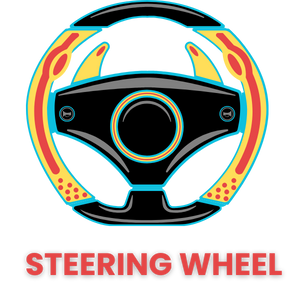The Ultimate Guide to Yoke Steering Wheel: Benefits, Models, and Customization
The automotive industry is no stranger to innovation, but few advancements have stirred as much discussion as the yoke steering wheel. Initially popularized by futuristic concept cars and aircraft, this unconventional steering mechanism has made its way into the mainstream, particularly in electric vehicles like Tesla.
The yoke steering wheel offers a unique driving experience, promising to revolutionize how we interact with our vehicles. But what exactly is a yoke steering wheel, and is it the right choice for you?
This guide delves deep into the world of yoke steering wheels, exploring their history, technological advancements, and everything you need to know to make an informed decision.
Unlike most articles that focus solely on the Tesla models, this guide will explore a broader range of vehicles featuring yoke steering wheels. Additionally, we’ll delve into the less-discussed aspects like ergonomic setup, customization options, and how to address common issues. This approach will ensure the content is not only informative but also practical for readers considering a switch to a yoke steering wheel.
Historical Background
Early Concepts
The concept of the yoke steering wheel dates back to the early days of aviation. Pilots needed a control mechanism that was compact and efficient, leading to the development of the yoke, which allows for precise maneuvers in limited space. The idea eventually caught the attention of automotive designers, who began experimenting with yoke-style steering wheels in concept cars as early as the 1950s.
Adoption in Modern Vehicles
It wasn’t until the 21st century that yoke steering wheels started gaining traction in the automotive industry, particularly with the rise of electric vehicles (EVs). Tesla, known for pushing the boundaries of car design, was among the first to incorporate yoke steering wheels in its vehicles, starting with the Tesla Model S Plaid in 2021. The decision was met with both excitement and skepticism, sparking a broader conversation about the future of steering wheel design.
Milestones
One of the most significant milestones in the adoption of yoke steering wheels was Tesla’s introduction of the feature as standard in the Model S Plaid. This move signaled a shift in how manufacturers view the role of steering wheels in the driving experience, paving the way for other automakers to follow suit. As more companies explore the integration of yoke steering wheels, we’re likely to see this design become more prevalent in the coming years.
Technological Advancements
Design Innovations
Yoke steering wheels are more than just a design statement; they represent a significant shift in the ergonomics and functionality of vehicle control. Unlike traditional round steering wheels, yoke steering wheels are flat and rectangular, providing a clear view of the dashboard and enhancing the overall driving experience. This design innovation is particularly beneficial in vehicles with advanced driver-assistance systems (ADAS), where unobstructed visibility of the instrument cluster is crucial.
Integration with Vehicle Systems
One of the key advantages of yoke steering wheels is their seamless integration with modern vehicle systems. In Tesla models, for example, the yoke steering wheel works in tandem with the car’s autopilot and full self-driving (FSD) features, allowing for a more intuitive control experience. The steering wheel’s design also complements the vehicle’s AI-driven capabilities, making it easier for drivers to transition between manual and autonomous driving modes.
Future Prospects
As automotive technology continues to evolve, so too will the capabilities of yoke steering wheels. We can expect future models to incorporate advanced haptic feedback, customizable controls, and even biometric sensors that adapt the steering response based on the driver’s physical state. These innovations will further enhance the driving experience, making yoke steering wheels a staple in the next generation of vehicles.
Key Features by Model
| Feature | Tesla Model S Plaid | Tesla Model X | Rivian R1T | Lucid Air |
|---|---|---|---|---|
| Build Quality | High | High | High | High |
| Material | Premium Leather | Premium Leather | Premium Leather | Premium Leather |
| Weight | 17 lbs (7.7 kg) | 18 lbs (8.2 kg) | 22 lbs (10 kg) | 21 lbs (9.5 kg) |
| Size | 13.8 inches (35 cm) | 14.1 inches (35.8 cm) | 15.7 inches (40 cm) | 15.5 inches (39.4 cm) |
| Airbag Integration | Yes | Yes | Yes | Yes |
| Heater Functionality | Yes (Heated Steering Wheel) | Yes (Heated Steering Wheel) | No | Yes (Heated Steering Wheel) |
| Lights/Illumination | Yes (Ambient & Control Lighting) | Yes (Ambient & Control Lighting) | Yes (Ambient & Control Lighting) | Yes (Ambient & Control Lighting) |
This table provides the specific details for each feature, allowing for a clearer comparison between the different yoke steering wheel models. Let me know if you need any further adjustments!
Tesla Models
Tesla’s implementation of the yoke steering wheel in the Model S Plaid and Model X has set a new standard in automotive design. The compact size and flat shape of the yoke provide an unobstructed view of the dashboard, enhancing the overall driving experience. The leather material used in the steering wheel ensures a premium feel, while the integrated airbag offers the same level of safety as traditional steering wheels. The addition of heater functionality and illumination makes driving more comfortable, especially in adverse weather conditions.
Other Notable Models
While Tesla has been the most prominent adopter of yoke steering wheels, other manufacturers are beginning to explore this design. The Rivian R1T, for example, features a yoke steering wheel that aligns with the vehicle’s rugged, off-road capabilities. Similarly, the Lucid Air, a luxury electric sedan, offers a yoke steering wheel that emphasizes both comfort and cutting-edge technology.
Top Yoke Steering Wheel Models for 2024

Tesla Models
When it comes to yoke steering wheels, Tesla remains the frontrunner, particularly with the Model S Plaid and Model X. These vehicles not only offer a unique driving experience but also showcase the potential of yoke steering wheels in mainstream vehicles. The benefits of Tesla’s yoke steering wheel include improved visibility, seamless integration with the vehicle’s advanced systems, and a futuristic design that sets it apart from traditional steering wheels.
Other Electric Vehicles
In addition to Tesla, other electric vehicles are beginning to feature yoke steering wheels, signaling a broader trend in the industry. The Rivian R1T, with its robust design and off-road capabilities, is another standout model. The Lucid Air, known for its luxury and performance, also incorporates a yoke steering wheel, offering a blend of comfort and cutting-edge technology. As more manufacturers adopt this design, we can expect to see a wider range of vehicles with yoke steering wheels in the coming years.
Comparison Table
| Model | Price (USD) | Build Quality | Material | Technology Integration | Comfort Features |
| Tesla Model S Plaid | $129,990 | High | Leather | Advanced | Heater, Illumination |
| Tesla Model X | $114,990 | High | Leather | Advanced | Heater, Illumination |
| Rivian R1T | $73,000 | High | Leather | Medium | No Heater |
| Lucid Air | $87,400 | High | Leather | Advanced | Heater, Illumination |
Optimal Setup and Usage
Ergonomic Setup
To get the most out of a yoke steering wheel, it’s essential to adjust it for optimal comfort and control. Start by ensuring that the steering wheel is at the right height and distance from your body. This will not only improve your driving posture but also reduce strain on your arms and shoulders during long drives. Additionally, take advantage of any tilt and telescoping adjustments available to fine-tune the steering wheel’s position.
Driving Techniques
Driving with a yoke steering wheel differs significantly from using a traditional steering wheel. The flat, rectangular shape may require some getting used to, particularly when making tight turns. To adapt, focus on using small, precise movements rather than the wide turns typically associated with round steering wheels. Over time, you’ll find that the yoke steering wheel offers a more responsive and engaging driving experience.
Safety Considerations
Safety should always be a priority when using a yoke steering wheel. One of the primary concerns is the potential difficulty in making quick, evasive maneuvers due to the steering wheel’s unconventional shape. To mitigate this risk, practice driving in a controlled environment, such as an empty parking lot, to familiarize yourself with the yoke’s handling characteristics. Additionally, ensure that the airbag integration is functioning correctly, as it plays a crucial role in protecting the driver in the event of a collision.
Customization Options
Steering Wheel Covers
Customizing your yoke steering wheel is a great way to enhance both its appearance and functionality. One of the most popular customization options is steering wheel covers. These covers come in a variety of materials, including leather, suede, and even carbon fiber, allowing you to choose one that matches your style and driving preferences. When selecting a cover, make sure it fits snugly around the yoke and doesn’t interfere with the vehicle’s controls.
Color and Material Customization
In addition to steering wheel covers, you can customize the color and material of your yoke steering wheel. Whether you prefer a sleek, all-black design or something more vibrant, there are plenty of options available. Some manufacturers offer bespoke customization services, allowing you to choose everything from the stitching color to the type of leather used. This level of personalization ensures that your yoke steering wheel is truly unique and tailored to your tastes.
Aftermarket Accessories
For those looking to enhance the functionality of their yoke steering wheel, a variety of aftermarket accessories are available. These include paddle shifters, custom grips, and even illuminated buttons. When selecting aftermarket accessories, it’s important to ensure that they are compatible with your vehicle and do not compromise the steering wheel’s safety features.
Common Issues and Solutions
Typical Problems
While yoke steering wheels offer a range of benefits, they are not without their challenges. Some common issues include difficulty handling tight turns, discomfort during long drives, and potential interference with the vehicle’s controls. Additionally, the unconventional shape of the yoke may take some time to get used to, particularly for drivers accustomed to traditional round steering wheels.
Causes and Diagnosis
Most issues with yoke steering wheels stem from their unique design. The flat, rectangular shape can make it difficult to perform certain maneuvers, particularly in situations that require quick, sharp turns. Discomfort during long drives is often caused by improper ergonomic setup or a lack of familiarity with the yoke’s handling characteristics. In some cases, the yoke’s shape may interfere with the vehicle’s controls, particularly if aftermarket accessories are not properly installed.
Solutions and Prevention
To address these issues, start by ensuring that your yoke steering wheel is properly adjusted for comfort and control. Practice driving in a safe, controlled environment to get used to the yoke’s handling characteristics. If discomfort persists during long drives, consider using a steering wheel cover or other ergonomic accessories to improve your grip and reduce strain. Finally, be cautious when installing aftermarket accessories, as improper installation can lead to safety issues.
Product Comparison
Price Comparison Table in USD
| Model | Price (USD) | Build Quality | Material | Technology Integration | Comfort Features |
| Tesla Model S Plaid | $129,990 | High | Leather | Advanced | Heater, Illumination |
| Tesla Model X | $114,990 | High | Leather | Advanced | Heater, Illumination |
| Rivian R1T | $73,000 | High | Leather | Medium | No Heater |
| Lucid Air | $87,400 | High | Leather | Advanced | Heater, Illumination |
Value for Money
When considering the value of a yoke steering wheel, it’s important to weigh the cost against the benefits. Tesla’s models, while on the higher end of the price spectrum, offer a range of advanced features that justify the investment. The Rivian R1T and Lucid Air, while more affordable, still provide a premium driving experience with their yoke steering wheels. Ultimately, the value for money will depend on your individual preferences and driving needs.
Conclusion
In conclusion, the yoke steering wheel represents a bold step forward in automotive design and functionality. Whether you’re drawn to its futuristic aesthetics or the enhanced driving experience it offers, there’s no denying that the yoke steering wheel is here to stay. As more manufacturers adopt this design, we can expect to see continued innovation and customization options, making the yoke steering wheel a versatile choice for a wide range of drivers.
Final thought:
If you’re considering a yoke steering wheel for your next vehicle, this guide has provided you with the information you need to make an informed decision. From understanding the historical background to exploring the latest models and customization options, you’re now equipped to take the wheel—literally.
Stay Connected and Spread the Words
For more automotive tips and advice, be sure to subscribe to our newsletter. If you found this guide helpful, share it with your friends on social media and help spread the word about the future of driving with yoke steering wheels.
Additional Resources
| Resource Type | Resource | Link |
|---|---|---|
| Official Websites | Tesla Official Website | Tesla Official Website |
| Rivian Official Website | Rivian Official Website | |
| Lucid Motors Official Website | Lucid Motors Official Website | |
| Product Manuals | Tesla Model S Plaid User Manual | Tesla Model S Plaid User Manual |
| Rivian R1T User Manual | Rivian R1T User Manual | |
| Lucid Air User Manual | Lucid Air User Manual | |
| Service Centers | Find a Tesla Service Center | Find a Tesla Service Center |
| Rivian Service Locations | Rivian Service Locations | |
| Lucid Motors Service Centers | Lucid Motors Service Centers | |
| Social Media Pages | Tesla on Facebook | Tesla on Facebook |
| Rivian on Instagram | Rivian on Instagram | |
| Lucid Motors on X | Lucid Motors on X |
This table provides a clear and organized view of the additional resources related to the yoke steering wheel models, including official websites, product manuals, service centers, and social media pages.
Frequently Asked Questions
Q No. 1: What is the benefit of a yoke steering wheel?
Answer: The yoke steering wheel offers several benefits that enhance both the driving experience and vehicle aesthetics. One of the primary advantages is the improved visibility it provides. Due to its flat, rectangular design, a yoke steering wheel allows drivers to have an unobstructed view of the dashboard, including critical displays and information panels. This is particularly beneficial in vehicles equipped with advanced driver-assistance systems (ADAS), as it ensures that important alerts and navigation information are always in clear view.
Additionally, the yoke steering wheel can contribute to a more ergonomic driving posture. Its compact shape allows for a more relaxed arm position, reducing strain during long drives. This design is also aesthetically modern, lending a futuristic look to the vehicle’s interior, which is especially appealing to tech-savvy drivers.
Q No. 2: Is a yoke better than a wheel?
Answer: Whether a yoke is better than a traditional steering wheel depends on the driver’s preferences and the driving context. The yoke steering wheel offers a unique driving experience, with benefits like improved visibility of the dashboard and a modern, minimalist design. It is particularly advantageous in vehicles that feature advanced autonomous driving technologies, where the driver does not need to perform frequent steering maneuvers.
However, the traditional circular steering wheel is generally more intuitive for most drivers, especially in situations that require quick, precise turns, such as in urban driving or during emergency maneuvers. While the yoke steering wheel can be more challenging to use in these scenarios, it excels in environments where driving assistance systems are heavily relied upon. Ultimately, the choice between a yoke and a traditional wheel will depend on the driver’s comfort level and the type of driving they do most often.
Q No. 3: Can you use a yoke as a steering wheel?
Answer: Yes, a yoke can indeed be used as a steering wheel, and it functions similarly to a traditional circular wheel, albeit with a different shape and feel. The yoke steering wheel operates the same way as a traditional wheel in terms of turning the vehicle, but it requires a different handling technique due to its unique shape. Drivers need to adapt to its design, especially when it comes to making sharp turns or maneuvering in tight spaces. Despite the initial learning curve, many drivers find that they can adjust to using a yoke steering wheel with practice.
Q No. 4: Is the yoke steering wheel optional?
Answer: In many cases, the yoke steering wheel is an optional feature, depending on the vehicle manufacturer and model. For example, Tesla offers the yoke steering wheel as a standard feature in some models, such as the Model S Plaid, but also provides an option to choose a traditional round steering wheel in other models. The availability of the yoke as an optional feature allows drivers to select the steering mechanism that best suits their driving style and preferences.
Q No. 5: What is the point of a yoke steering wheel?
Answer: The primary point of a yoke steering wheel is to provide a more modern, minimalist driving experience while enhancing the driver’s visibility and ergonomics. By eliminating the top half of the traditional circular steering wheel, the yoke design ensures that the driver has an unobstructed view of the dashboard, which is crucial for monitoring important driving information. Additionally, the yoke steering wheel complements the design of vehicles that are heavily reliant on autonomous driving systems, making the overall driving experience more seamless and futuristic.
Q No. 6: Is a yoke better than a steering wheel?
Answer: The comparison between a yoke and a traditional steering wheel largely depends on the context in which they are used. The yoke steering wheel offers benefits such as improved visibility, a more ergonomic hand position, and a sleek, modern aesthetic, making it a good fit for vehicles with advanced driving technologies. However, traditional steering wheels are generally more versatile and easier to use, particularly in situations that require precise and frequent steering adjustments, such as city driving or parking. Therefore, while a yoke may be better in some aspects, a traditional steering wheel may be preferable for other driving scenarios.
Q No. 7: Is Tesla yoke steering optional?
Answer: Yes, Tesla’s yoke steering wheel is optional in some models. While the yoke is standard in the Tesla Model S Plaid, Tesla offers customers the choice between a yoke steering wheel and a traditional round steering wheel in other models. This flexibility allows Tesla drivers to choose the steering option that best aligns with their driving preferences and comfort levels.
Q No. 8: Why do race cars use yoke steering wheels?
Answer: Race cars use yoke steering wheels primarily for their compact size and the precision they offer. The yoke design provides drivers with a more direct connection to the vehicle’s steering, allowing for quicker and more accurate adjustments during high-speed maneuvers. Additionally, the yoke steering wheel’s smaller size reduces the amount of physical movement required by the driver, which is crucial in the fast-paced environment of racing. This design helps drivers maintain control and focus, particularly in situations where split-second decisions can make a significant difference in performance.
Q No. 9: Can you swap out the yoke steering wheel?
Answer: Yes, it is possible to swap out a yoke steering wheel for a traditional round steering wheel, depending on the vehicle’s design and compatibility. Some manufacturers, including Tesla, offer the option to replace the yoke steering wheel with a conventional round steering wheel as an aftermarket modification. However, it is essential to ensure that the replacement is done by a professional to maintain the vehicle’s safety features, such as airbag integration and steering functionality. Before making such a swap, it’s advisable to consult with the vehicle manufacturer or a certified technician to understand the implications and costs involved.









Leave a Reply